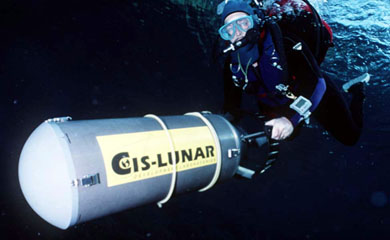 | |
           2026 Sistema Cheve |
Wakulla 2 Technology
Scooters, or Diver Propulsion Vehicles (DPVs) Why use scooters? By traveling faster through the water -- up to four times faster than an individual can normally swim with fins -- it is possible to dramatically reduce decompression time while still accomplishing a given mission. Conventional scooters, both commercial models and customized derivatives have an absolute range of 2 - 3 hours. To exceed this limitation, exploration teams typically stage scooters, such that teams can switch scooters at appropriate times. However, the Wakulla 2 Project is based in part on two new concepts: use of the 3-D mapper to survey caves in a manner heretofore never realized; and to make each exploration team completely self-contained, obviating the need for staging techniques and the attendant support divers, pyramid logistics, and so on. When the analysis was performed for the power consumption of the mapper, together with the desired exploration range, it was realized that a completely new approach to scooter design was called for. The result is the "Fatman" DPV (so named in honor of a certain bomb to which it bears an uncanny resemblance). The fundamental difference with the Fatman DPV and all previous scooters is the use of Nickel Metal Hydride (NiMH) batteries. Although many people will be familiar with the use of this battery chemistry in portable electronics, it is also the leading battery technology used in electric cars. NiMH batteries offer twice the energy density of lead-acid cells together with a superior discharge curve. The result is an energy source that is ideal for long-range DPV use. The weight of the NiMH cells (they are considerably more dense than lead acid batteries) together with the propulsion requirements of the mapper required a completely new design. The result is a device with the following characteristics:
Notwithstanding the impressive performance of the Fatman scooter, an explorer relying solely on one DPV would violate the requirements for always having a redundant system. Therefore, each explorer will also tow a conventional (lead acid based) scooter (the Thinman). This scooter has sufficient range to get the diver back from the deepest point of penetration. As a final note, it is useful to point out that even in the event of a complete dual DPV failure it would be possible, using the MK-5R system to literally walk out of the cave from the point of maximum penetration (although, of course, swimming would be faster). |
| Copyright © 2026 U.S. Deep
Caving Team, Inc. All rights reserved. Todo el contenido tiene derechos de autor del U.S. Deep Caving Team. Todos los derechos reservados. No portion of these pages may be used for any reason without prior written authorization. | |

